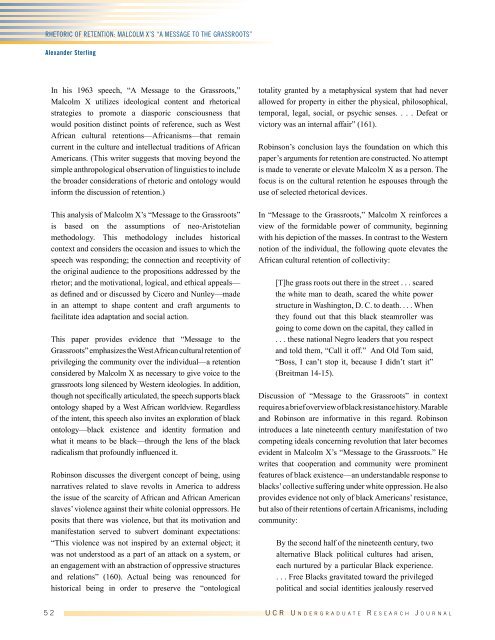Undergraduate Research Journal
Undergraduate Research Journal
Undergraduate Research Journal
Create successful ePaper yourself
Turn your PDF publications into a flip-book with our unique Google optimized e-Paper software.
Rhetoric of Retention: Malcolm X’s “A Message to the Grassroots”<br />
Alexander Sterling<br />
In his 1963 speech, “A Message to the Grassroots,”<br />
Malcolm X utilizes ideological content and rhetorical<br />
strategies to promote a diasporic consciousness that<br />
would position distinct points of reference, such as West<br />
African cultural retentions—Africanisms—that remain<br />
current in the culture and intellectual traditions of African<br />
Americans. (This writer suggests that moving beyond the<br />
simple anthropological observation of linguistics to include<br />
the broader considerations of rhetoric and ontology would<br />
inform the discussion of retention.)<br />
This analysis of Malcolm X’s “Message to the Grassroots”<br />
is based on the assumptions of neo-Aristotelian<br />
methodology. This methodology includes historical<br />
context and considers the occasion and issues to which the<br />
speech was responding; the connection and receptivity of<br />
the original audience to the propositions addressed by the<br />
rhetor; and the motivational, logical, and ethical appeals—<br />
as defined and or discussed by Cicero and Nunley—made<br />
in an attempt to shape content and craft arguments to<br />
facilitate idea adaptation and social action.<br />
This paper provides evidence that “Message to the<br />
Grassroots” emphasizes the West African cultural retention of<br />
privileging the community over the individual—a retention<br />
considered by Malcolm X as necessary to give voice to the<br />
grassroots long silenced by Western ideologies. In addition,<br />
though not specifically articulated, the speech supports black<br />
ontology shaped by a West African worldview. Regardless<br />
of the intent, this speech also invites an exploration of black<br />
ontology—black existence and identity formation and<br />
what it means to be black—through the lens of the black<br />
radicalism that profoundly influenced it.<br />
Robinson discusses the divergent concept of being, using<br />
narratives related to slave revolts in America to address<br />
the issue of the scarcity of African and African American<br />
slaves’ violence against their white colonial oppressors. He<br />
posits that there was violence, but that its motivation and<br />
manifestation served to subvert dominant expectations:<br />
“This violence was not inspired by an external object; it<br />
was not understood as a part of an attack on a system, or<br />
an engagement with an abstraction of oppressive structures<br />
and relations” (160). Actual being was renounced for<br />
historical being in order to preserve the “ontological<br />
totality granted by a metaphysical system that had never<br />
allowed for property in either the physical, philosophical,<br />
temporal, legal, social, or psychic senses. . . . Defeat or<br />
victory was an internal affair” (161).<br />
Robinson’s conclusion lays the foundation on which this<br />
paper’s arguments for retention are constructed. No attempt<br />
is made to venerate or elevate Malcolm X as a person. The<br />
focus is on the cultural retention he espouses through the<br />
use of selected rhetorical devices.<br />
In “Message to the Grassroots,” Malcolm X reinforces a<br />
view of the formidable power of community, beginning<br />
with his depiction of the masses. In contrast to the Western<br />
notion of the individual, the following quote elevates the<br />
African cultural retention of collectivity:<br />
[T]he grass roots out there in the street . . . scared<br />
the white man to death, scared the white power<br />
structure in Washington, D. C. to death. . . . When<br />
they found out that this black steamroller was<br />
going to come down on the capital, they called in<br />
. . . these national Negro leaders that you respect<br />
and told them, “Call it off.” And Old Tom said,<br />
“Boss, I can’t stop it, because I didn’t start it”<br />
(Breitman 14-15).<br />
Discussion of “Message to the Grassroots” in context<br />
requires a brief overview of black resistance history. Marable<br />
and Robinson are informative in this regard. Robinson<br />
introduces a late nineteenth century manifestation of two<br />
competing ideals concerning revolution that later becomes<br />
evident in Malcolm X’s “Message to the Grassroots.” He<br />
writes that cooperation and community were prominent<br />
features of black existence—an understandable response to<br />
blacks’ collective suffering under white oppression. He also<br />
provides evidence not only of black Americans’ resistance,<br />
but also of their retentions of certain Africanisms, including<br />
community:<br />
By the second half of the nineteenth century, two<br />
alternative Black political cultures had arisen,<br />
each nurtured by a particular Black experience.<br />
. . . Free Blacks gravitated toward the privileged<br />
political and social identities jealously reserved<br />
5 2 U C R U n d e r g r a d u a t e R e s e a r c h J o u r n a l














